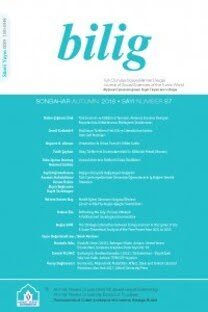Kazakistan'da Tarihi Canlandıran ve Milli Kimliği İnşa Eden Müzeler
Günümüzde müzeler, sadece değerli sanat eserlerinin sergilendiği mekanlar olmaktan çıkmış, aynı zamanda toplumların tarihlerinin yeniden yazıldığı ve milli kimliklerinin yeniden inşa edildiği mekanlar haline gelmiştir. Dolayısıyla, toplumsal tarih müzeleri sosyal bilimciler için bir araştırma alanı olmuştur. Bu makalede, Kazakistan'ın bağımsızlığı sonrasında Almatı ve Çimkent'te kurulmuş iki müzeden hareketle, Kazak milli kimliğinin nasıl yeniden üretildiği ve Kazakistan tarihinin nasıl yeniden yazıldığı incelenmektedir. Ayrıca, bu makale müzecilik, ulus-devlet ve ideoloji ilişkisini hem kurumsal hem de sembolik açıdan irdelemektedir.
Museums Which Revive History and Construct National Identity in Kazakhstan
Nowadays museums are not places where only valuable works of art are exhibited but also places where the history of societies are rewritten and national identities are constructed. Thus, social history museums became a field of research for social scientists. This article analyses the construction of Kazakh national identity and the rewriting of the history of Kazakhstan based on two museums established in Almati and Chimkent after the independence. The article also studies the relationship between museology, nation-state and ideology both from institutional and symbolic perspectives..
___
ANDERSON, Benedict (1983), Imagined Communities, London:Verso.ARSEBÜK, Güven (1983), "Dünden Bugüne Arkeoloji", Cumhuriyet Dönemi Türkiye Ansiklopedisi, I, İstanbul: İletişim.
BRAUDEL, Fernand, (1973), Capitalism and Material Life, New York: Harper and Row
DİTCHEV, Ivaylo (2001), "Les Metamorphoses de L'Identite Bulgare: Musee et Imaginaire National", Ethnologie Française XXXI, (2) 329-336.
FOUCAULT, Michel (1980), Power/Knowledge-Selected Interviews and Other Writings 1972-77, (ed. C. Gordon), Brighton: Harvester Press.
GONEN, Rivka (2001), "Müze Bağlamında Toplumsal Çoğulculuk: Amaçlar ve İkilemler", Kent, Toplum, Müzeler-Deneyimler-Katkılar içinde, İstanbul: Tarih Vakfı Yayınları, 154-165.
HALL, Stuart (1997), Representation-Cultural Representations and Signifying Practices, Londra: Sage.
HUDSON, Kenneth ve Ann NICHOLLS (eds) (1985), Directory of Museums and Living Displays, Londra: Macmillan.
KNOWLES, Loraine (2001), "Müze Gündeminde Toplumsal Tarih Kavramını Geliştirmek", Kent, Toplum, Müzeler-Deneyimler-Katkılar içinde, İstanbul: Tarih Vakfı Yayınları, 14-20.
KUNDAKÇI, Gül E. (2002), "19.Yüzyılda Anadolu Arkeolojisine ve Eskiçağ Tarihine Genel Yaklaşım", XIII. Türk Tarih Kongresi, 4-8 Ekim 1999, Kongreye Sunulan Bildiriler, Ankara: Türk Tarih Kurumu. 1083-1094.
MACDONALD, Sharon (1996), "Introduction", Macdonald ve Fyfe (der), Theorising Museums, Oxford: Blackwell. 1-18.
MARIEN, Van Der Heijden, hhtp://www.iisg.nl/publications/ mir-intro.htmI (1998)
OLCOTT, Martha Brill (1995), The Kazakhs, Stanford: Hoover Institute Press.
PRÖSLER, Martin (1996), "Museums and Globalization", Macdonald ve Fyfe (der), Theorising Museums, Oxford: Blackwell, 21-44.
SARSEMBAYEV, Azamat (1999), "Imagined Communities: Kazak Nationalism and Kazakification in the 1990's", Central Asian Survey, 18 (3): 319-346.
SKRYPNYK, Hanna (2004), "Les Musees Ethnographiques en Ukraine", Ethnologie Française XXXIV, (2): 309-317.
ZOLBERG, Vera L. (1996), "Museums as Contested Sites of Remembrance: The Enola Gay Affair", Macdonald ve Fyfe (eds), Theorising Museums, Oxford: Blackwell. 69-82.
- ISSN: 1301-0549
- Yayın Aralığı: Yılda 4 Sayı
- Başlangıç: 1996
- Yayıncı: Ahmet Yesevi Üniversitesi Mütevelli Heyet Başkanlığı
Sayıdaki Diğer Makaleler
"Yugoslavya-Makedonya" Topraklarından Türkiye'ye Göçler ve Nedenleri
Ethics in Agenda Building Process in Press Organizations: A Behaviorial Approach
Stalin Dönemindeki Siyasi Muhalifleri Tasfiye Uygulamaları ve Çalıştırma Kampları
Devletin Kurumsal Dönüşümü: Orta Asya Cumhuriyetleri Perspektifinden
Türk Edebiyatı Tarihi, Kültür ve Turizm Bakanlığı Yayınları, İstanbul, 2006, 2644 s
Kimliklerin Çatıştığı Mekan: "Kiralık Konak" ve Evini/Evrenini Arayan Nesiller
Kazakistan'da Tarihi Canlandıran ve Milli Kimliği İnşa Eden Müzeler
